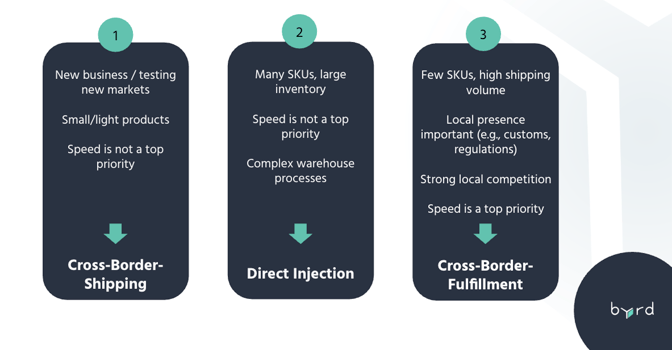Direct Injection in E-Commerce
Table of Content
Expanding your online shop across Europe? Direct injection is one is one way to efficiently cut cross-border shipping costs and speed up deliveries - especially with increasing volumes.. Still, many merchants still don’t fully understand how it works and when the right time to use it is. Here’s what you need to know.
What Is Direct Injection in E-Commerce?
Direct injection involves bundling multiple cross-border orders together and transporting them in bulk to the destination country, where a local carrier handles the final-mile delivery.
Think of it as “group shipping”:
- Orders for, say, France are collected in your central warehouse (e.g., Germany).
- They are shipped together in one truck or pallet load to France.
- A local carrier (e.g., Colissimo, Mondial Relay) delivers them as domestic parcels.
When Direct Injection Makes Sense
While there are many advantages of direct injection, it is not the best solution for every merchant. Consider it if:
- You ship at least a few hundred orders/month per country.
Below that threshold, the setup and operational overhead may outweigh the potential savings. - Your products are medium-sized parcels with a bit more weight (e.g., pet food, supplements, beauty, healthcare, consumer goods). Very small, lightweight products might be cheaper via postal services (e.g. DHL Kleinpaket)
- You Need Scalable International Logistics.
As your business grows, Direct Injection serves as a scalable bridge between cross-border shipping and full local fulfillment. It’s well-suited for merchants who are expanding quickly and want a logistics model that can adapt to increasing volumes.
Smart Strategies for Direct Injection
- Choose Country-Specific Carriers
Don’t just stick to your default carrier. In France, for example, Colissimo and Mondial Relay often outperform international DHL in cost and delivery speed, as well as local delivery preferences. - Work With Specialized Providers
Providers like exporto or similar handle line-haul transport, customs clearance (for CH/UK), and carrier handover, saving you time. - Bundle More Than Parcels
If you also sell B2B, direct injection can combine retail orders and wholesale shipments in the same truck for even better rates. - Negotiate Early
Even if you’re not shipping thousands yet, showing your projected growth to providers can help you lock in better rates. To facilitate negotiations, working with a 3PL can help you unlock better rates or this solution in general because they can, in many cases, bundle several brands to fill a truck.
Example: 30% Cost Savings to Switzerland
At byrd, we regularly see how customers can cut their costs by using the direct injection strategy. One example is a healthcare brand shipping ~300 orders/month to Switzerland. They reduced shipping costs from €12–15 per parcel (standard DHL) to €9–13 by bundling orders via a direct-injection provider. Delivery speed remained similar, but the cost savings added up to more than €10,000 euros per year.
Direct Injection vs. Other Strategies

If you want to learn more about the classic cross-border shipping strategy, or the multi-warehouse cross-border fulfillment strategy, read on in this cross-border logistics strategies overview.
Wrapping Up: Should You Use Direct Injection?
Direct Injection sits perfectly between traditional cross-border shipping and full local fulfillment. It offers a practical, scalable solution for growing brands that want to cut costs and improve the customer experience without the complexity of managing multiple warehouses.
If you're sending steady volumes to a specific country and want to scale your logistics without overcommitting, Direct Injection is a smart, future-proof move. As your business grows, it can serve as a strategic stepping stone toward full local fulfillment when the time is right.